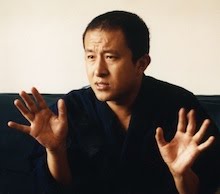The recording of our conversation is available here.
Monday, September 21, 2009
Tibetan Buddhism in the West
This week, our topic was "Tibetan Buddhism in the West", drawing on a series of three articles. The first is by Alan Wallace; there was a reply/response by Tara Carreon, and Rinpoche then wrote his own reply to both these articles. Here are the links:
Labels:
alan wallace,
Buddhism in the West,
DJKR,
tara carreon,
tibetan buddhism
Wednesday, September 16, 2009
21 Praises to Tara
 Several people have asked about the "21 Praises to Tara", which many of us have been practicing for Rinpoche's long life (and which we will also be practicing during a 10-day Tara retreat at SSRC in December).
Several people have asked about the "21 Praises to Tara", which many of us have been practicing for Rinpoche's long life (and which we will also be practicing during a 10-day Tara retreat at SSRC in December). Here are some resources available online that you might find interesting and helpful if you are doing this practice:
- Chants for the 21 Praises to Tara, including both slow/fast versions (by Erik Pema Kunsang, here)
- Pictures and descriptions of each of the 21 Taras (available here). As the site notes, " Basically the colors are a code for the 4 activities: pacifying (white), enriching (yellow), subjugating (red) and eliminating (black.) Mixed colors such as orange indicate a combination of qualities"
Buddhist History - Week 6
Here's the recording from our meeting on 5 September. We took a break from Conze's review of early Buddhist history to look at Alan Wallace's review of trends in contemporary Buddhism, specifically "The Spectrum of Buddhist Practice in the West" (available here). The parallels between the development of the Mahayana in India and the transition of Buddhism to the West are quite remarkable, and suggest that the development of a new form of Buddhism adapted to the pre-existing Western social, cultural and intellectual environment is inevitable. We started to look at some aspects of what this might include. Some topics we discussed include:
- The challenges of adaptation: the risk of over-simplifying by throwing too much out, and the risk of including elements from other cultures that aren't relevant to the West
- The importance for the current generation of Buddhist practitioners in ensuring an authentic transmission of dharma to the West
- In Tibet, the ecumenical (rimé) movement sought to overcome divisiveness among the four Tibetan schools. In the West, these four are also interacting with all the other Buddhist traditions such as Zen, Vipassana, Japanese Buddhism etc, in a way that is historically unprecedented. What might a rimé movement look like in the West?
Buddhist History - Week 5

Apologies for belated posting. Summer holidays and retreat beckoned. Here's the recording of our meeting on 30 August, continuing our study of the second 500-year period of Buddhist history (from Conze's "Buddhist History"), from 0 AD to 500 AD. Among other topics, we covered:
- Mindfulness in the Mahayana and mindfulness in "insight meditation" traditions
- The integration of practice into daily life
- The importance of nonduality and going beyond extremes
Subscribe to:
Posts (Atom)
.jpg)
.jpg)